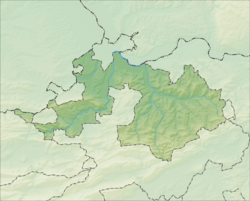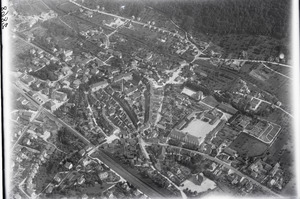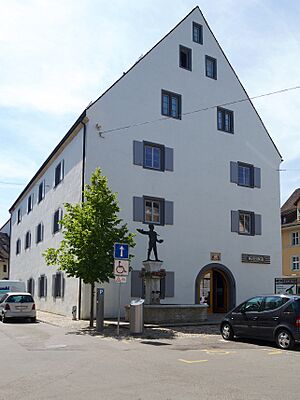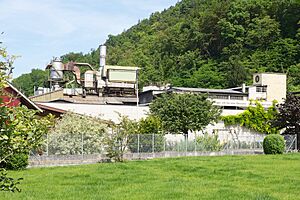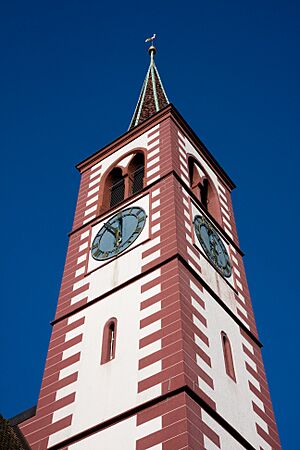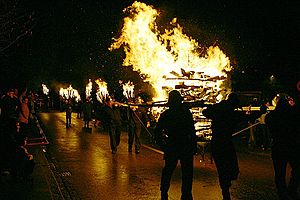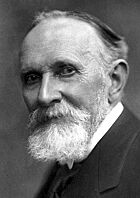Liestal facts for kids
Quick facts for kids
Liestal
|
||
|---|---|---|
 |
||
|
||
| Country | Switzerland | |
| Canton | Basel-Landschaft | |
| District | Liestal | |
| Area | ||
| • Total | 18.18 km2 (7.02 sq mi) | |
| Elevation | 327 m (1,073 ft) | |
| Population
(Jun 2021 )
|
||
| • Total | 14,963 | |
| • Density | 823.05/km2 (2,131.7/sq mi) | |
| Postal code |
4410
|
|
| Surrounded by | Arisdorf, Bubendorf, Frenkendorf, Füllinsdorf, Hersberg, Lausen, Nuglar-St. Pantaleon (SO), Seltisberg | |
| Twin towns | Onex (Switzerland), Sacramento (US), Waldkirch (Germany) | |
Liestal is the capital city of the canton of Basel-Landschaft in Switzerland. It's located about 17 kilometers (11 miles) south of Basel.
Liestal is known as an industrial town, but it also has a beautiful cobbled-street Old Town. The main language spoken here is a local Alemannic Swiss German dialect, even though the official language is Standard German.
Contents
History of Liestal
The name Liestal was first written down in 1225. However, people lived in this area much earlier, even during Roman times! The town grew because of its great location. It was on the main road between the first bridge over the Rhine River in Basel and the important St. Gotthard Pass through the mountains.
Wars and Rebellions
Citizens from Liestal took part in the Burgundian Wars in 1476 and 1477. They fought against a powerful ruler named Charles the Bold. In 1501, Liestal joined the Swiss Confederation. This led to many disagreements with its neighbor, Rheinfelden, which was controlled by the Habsburg family.
In the 1600s, Liestal rebelled against Basel during the Farmers' Rebellion. Basel's troops took over the town, and three leaders of the rebellion were sadly executed.
French Influence and Independence
When the French Revolution happened in 1789, Liestal was excited about the ideas of freedom and equality. They even celebrated Napoleon when he visited in 1797. But after Napoleon's power ended, Liestal went back to being under Basel's control.
However, another revolution in France in 1830 sparked changes in Liestal. A temporary government was set up, and on March 17, 1832, Liestal was chosen as the capital of a new canton. This was a big step towards its independence!
Geography of Liestal
Liestal covers an area of about 18.19 square kilometers (7.02 sq mi). A large part of this land, about 58.7%, is covered by forests. About 16.4% is used for farming, and 23.9% has buildings or roads. A small amount, 0.5%, is rivers or lakes.
The old town of Liestal is built on a rocky area between two rivers, the Ergolz and Orisbach. It's located between Basel and the Jura Mountains. The town has a unique fan shape, with a wide main street and two side streets. Over time, small neighborhoods grew around the old city gates.
Coat of Arms
The coat of arms for Liestal shows a red crozier (a hooked staff like a bishop's staff) on a silver background, with a red section below it.
Population and Languages
Liestal has a population of about 15,000 people. Many people from other countries live here, making it a diverse place.
Most people in Liestal, about 83.2%, speak German. The second most common language is Italian, spoken by about 5.1% of the population. Other languages like Serbo-Croatian and French are also spoken.
Historic Population
The chart below shows how Liestal's population has changed over many years:
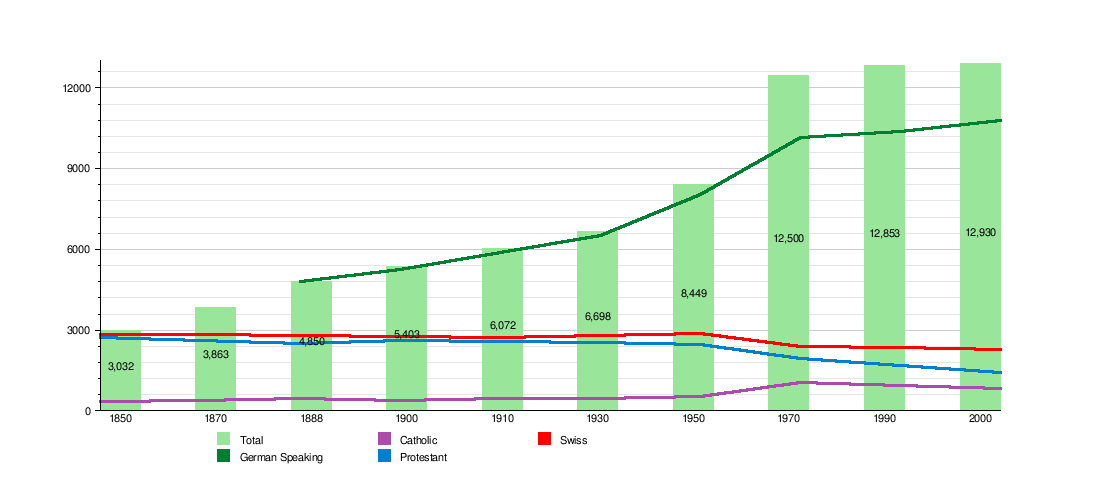
Important Heritage Sites
Several places in Liestal are very important and are listed as Swiss heritage sites of national significance. These include:
- The Depot of Archeology of Basel-land, where ancient artifacts are kept.
- The Frenkenbrücke, which is an old bridge.
- The Munzach, a Roman farmhouse from ancient times.
- A Roman aqueduct, which was used to carry water.
- The Cantonal Archive of Basel-Landschaft, where important historical documents are stored.
Also, the entire old town of Liestal is recognized as an important heritage site.
Economy of Liestal
Liestal is a busy place for work! In 2005, about 160 people worked in farming, which is the primary economic sector. Many more people, about 2,324, worked in the secondary sector, which includes manufacturing and construction. The largest number of jobs, about 10,189, were in the tertiary sector. This sector includes jobs in sales, transportation, hotels, restaurants, finance, education, and healthcare.
Many people who live outside Liestal travel into the city for work. Liestal is a place where more people come in for work than leave for work. About 25.8% of workers use public transportation, and 35.7% use a private car to get to work.
Religion in Liestal
According to a census from 2000, many people in Liestal belong to Christian churches. About 28.2% were Roman Catholic, and 43.5% belonged to the Swiss Reformed Church. There were also people who belonged to Orthodox and other Christian churches.
Some people in Liestal follow other religions, like Islam (about 5.41%) and Judaism. There were also people who were Buddhist or Hindu. About 12.71% of the population said they didn't belong to any church or were agnostic or atheist.
Education in Liestal
Education is important in Liestal! About 38% of the people have finished upper secondary education, which is like high school. And about 14.7% have gone on to higher education, either at a university or a specialized college.
Liestal has two libraries: the Kantonsbibliothek Baselland and the Pädagogische Hochschule library. In 2008, these libraries had over 249,000 books and other media, and they loaned out more than 757,000 items!
Local Customs and Festivals
One of Liestal's most exciting traditions is Chienbäse. This happens on the Sunday night after Mardi Gras. It's a spectacular parade with huge bonfires! People carry burning bundles of wood through the streets. This tradition has been going on since at least the 16th century. Other towns nearby also have similar celebrations.
Other local festivals include:
- Santichlaus-Ylüüte
- Banntag
Transport in Liestal
Liestal is a well-connected town! The Liestal railway station is on the main Hauenstein railway line, which links Basel and Olten. You can catch trains to Basel, Olten, Bern, Lucerne, and Zürich from here. Some trains even go all the way to Frankfurt and Berlin!
The station is also where the Waldenburg narrow gauge railway starts and ends. This railway runs trains every 15 minutes to Waldenburg.
If you prefer driving, the A3 motorway passes through Liestal, connecting Basel and Zürich.
Notable People from Liestal
Many interesting people have connections to Liestal:
- Johann Bernhard Merian (1723–1807): A philosopher who was active in the Prussian Academy of Sciences.
- Abel Seyler (1730–1800): A theater director and former merchant.
- Carl Spitteler (1845–1924): A famous Swiss poet who won the Nobel Prize for Literature in 1919.
- Karl Wilhelm Ritter (1847–1906): A civil engineer and professor.
- Wilhelm Eduard Brodtbeck (1873–1957): A well-known architect.
- Matthias Gelzer (1886–1974): A historian who studied Ancient Rome.
- Bohuslav Martinů (1890–1959): A Czech composer of classical music.
- Martin Schadt (born 1938): A Swiss physicist and inventor.
- Enrico Marini (born 1969): An Italian comics artist.
- Davide Cali (born 1972): An Italian writer of children's books and graphic novels.
Sports Stars
Liestal has also produced several talented athletes:
- Rico Freiermuth (born 1958): A Swiss bobsledder who won a bronze medal at the 1984 Winter Olympics.
- Adrian Knup (born 1968): A retired Swiss football player who played for the Swiss national team.
- David Degen (born 1983): A former Swiss football player who also played for the Swiss national team.
- Philipp Degen (born 1983): David's twin brother, also a retired Swiss football player who played for the Swiss national team.
- Fabian Leimlehner (born 1987): An Austrian artistic gymnast who competed at the 2012 Summer Olympics.
- Yanik Frick (born 1998): A football player from Liechtenstein.
International Connections
Liestal is twinned with a few other cities around the world. This means they have special friendly relationships and often share cultural exchanges.
|
See also
 In Spanish: Liestal para niños
In Spanish: Liestal para niños




